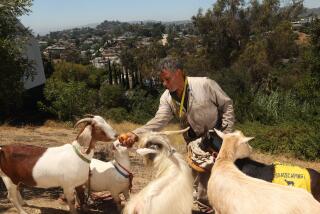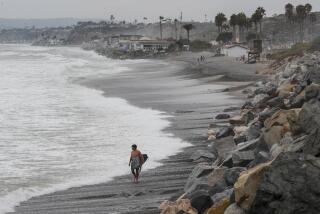Goats Finally Find a Believer : Livestock: Nearly eradicated by the Navy, the San Clemente goat is in fact highly desirable as a milk and meat source, a scientist says. He is trying to save the breed.
- Share via
For nearly two decades, the goats of San Clemente Island were considered a nuisance by the Navy and subjected to intense extermination efforts. Now, a University of Florida scientist is working on the other side of the continent to save the animals from extinction.
If bred correctly, the San Clemente goat could help provide a large part of the developing world with a superior source of milk and meat, said Sebastian Heath, an assistant professor at the university’s College of Veterinary Medicine.
Most goats produce either milk or meat, Heath said, but the San Clemente goat can be used for both.
Also, it is resistant to parasites and many diseases that plague other breeds, Heath said, adding that the San Clemente goats are among the oldest and most resilient in North America.
Heath said that the Caribbean and parts of Africa are just two areas where goats are a major source of food.
“There is a common disease in these goats which is similar to HIV infection and causes arthritis, but the San Clemente goats are completely free of it,” he said.
Heath has collected semen from three San Clemente goats that live at a Georgia breeding farm. Some of the semen will be used to artificially inseminate several San Clemente goats, and some will be kept in long-term storage.
“The name of the game is to try and preserve as many as we can,” he said. “By collecting semen and storing it, we can fertilize doe goats and keep the species going.”
It is believed that at one time more than 30,000 goats occupied San Clemente Island, a rugged 51-square-mile patch of land about 65 miles west of San Diego. However, since 1972 more than 20,000 goats have been shot or trapped by the Navy to protect various species of flora and fauna that biologists said faced extinction.
Today few goats live on the island, and Heath estimates that there are only about 100 of the San Clemente goats left in the country.
The goats’ resilience makes them vital research specimens, Heath said. Still, he said, the near obliteration of the goats by the Navy will have long-term effects.
“The Navy probably didn’t want to get rid of the breed,” he said. “But the goats were in such an abundance they probably never considered the importance of this breed, because if they had we wouldn’t have to be saving them now.”
Although the animals may have been considered bothersome by the Navy, Heath said their importance is undeniable.
“Consider that there is more goat milk and meat eaten on a worldwide basis than cows’ milk or meat,” he said. “That’s how important the San Clemente goat is.”
More to Read
Sign up for Essential California
The most important California stories and recommendations in your inbox every morning.
You may occasionally receive promotional content from the Los Angeles Times.












